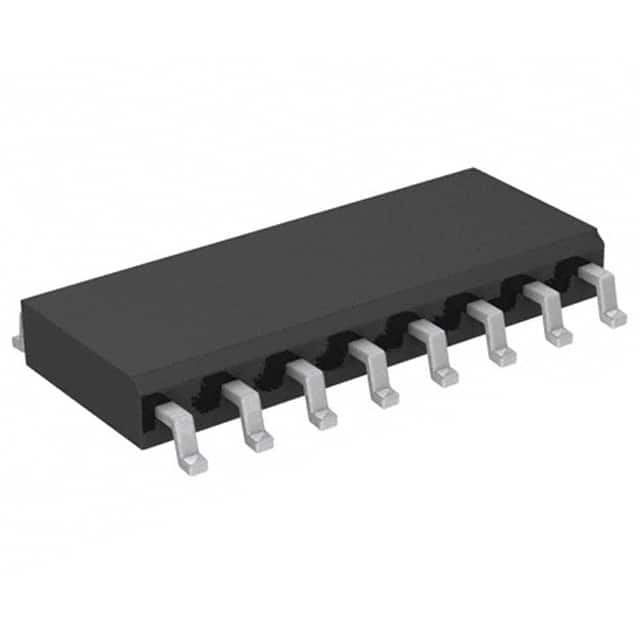74HC174D-Q100J
Product Overview
- Category: Integrated Circuit (IC)
- Use: Flip-Flop
- Characteristics: High-speed, low-power, CMOS technology
- Package: SOIC (Small Outline Integrated Circuit)
- Essence: Hex D-type flip-flop with reset; positive-edge trigger
- Packaging/Quantity: Tape and Reel, 2500 pieces per reel
Specifications
- Supply Voltage Range: 2.0V to 6.0V
- High-Level Input Voltage: 2.0V to VCC
- Low-Level Input Voltage: GND to 0.8V
- High-Level Output Voltage: VCC - 0.5V
- Low-Level Output Voltage: 0.5V
- Maximum Operating Frequency: 125 MHz
- Propagation Delay: 13 ns
- Operating Temperature Range: -40°C to +125°C
Detailed Pin Configuration
The 74HC174D-Q100J has a total of 16 pins, which are assigned specific functions as follows:
- CLR (Clear) - Active LOW input for resetting the flip-flop.
- D0-D5 (Data Inputs) - Inputs for the six D-type flip-flops.
- Q0-Q5 (Outputs) - Outputs of the corresponding flip-flops.
- CP (Clock Pulse) - Positive-edge triggered clock input.
- GND (Ground) - Ground reference voltage.
- VCC (Supply Voltage) - Positive power supply.
Functional Features
- Hex D-Type Flip-Flop: The 74HC174D-Q100J consists of six individual D-type flip-flops, allowing for the storage and transfer of data.
- Reset Functionality: The clear input (CLR) allows for the simultaneous reset of all flip-flops to a known state.
- Positive-Edge Trigger: The flip-flops are triggered by the positive edge of the clock pulse (CP) input.
Advantages and Disadvantages
Advantages: - High-Speed Operation: The 74HC174D-Q100J operates at a maximum frequency of 125 MHz, making it suitable for high-speed applications. - Low Power Consumption: Utilizing CMOS technology, this IC offers low power consumption, resulting in energy-efficient operation. - Compact Package: The SOIC package provides a compact form factor, allowing for space-saving integration into various electronic systems.
Disadvantages: - Limited Voltage Range: The supply voltage range of 2.0V to 6.0V may restrict compatibility with certain systems operating outside this range. - Propagation Delay: The propagation delay of 13 ns may introduce timing constraints in applications requiring precise synchronization.
Working Principles
The 74HC174D-Q100J operates based on the principles of D-type flip-flops. Each flip-flop stores a single bit of data and transfers it to the output upon receiving a clock pulse. The clear input allows for resetting all flip-flops simultaneously. The positive-edge trigger ensures that the data is captured and transferred at the rising edge of the clock signal.
Detailed Application Field Plans
The 74HC174D-Q100J finds applications in various fields, including:
- Digital Communication Systems: Used for data storage and transfer in communication protocols such as UART, SPI, and I2C.
- Microcontroller-Based Systems: Employed for general-purpose data storage and synchronization in microcontroller-based designs.
- Industrial Automation: Integrated into control systems for sequential logic operations and state machine implementations.
- Automotive Electronics: Utilized in automotive control units for reliable data storage and synchronization.
Detailed and Complete Alternative Models
- SN74HC174 - Similar hex D-type flip-flop with reset, offered by Texas Instruments.
- CD40174 - Hex D-type flip-flop with reset, available from various manufacturers.
- MC74HC174 - High-speed CMOS hex D-type flip-flop with reset, manufactured by ON Semiconductor.
These alternative models provide similar functionality and can be considered as substitutes for the 74HC174D-Q100J in different applications.
Word count: 534 words
قم بإدراج 10 أسئلة وإجابات شائعة تتعلق بتطبيق 74HC174D-Q100J في الحلول التقنية
Sure! Here are 10 common questions and answers related to the application of 74HC174D-Q100J in technical solutions:
Q: What is the 74HC174D-Q100J? A: The 74HC174D-Q100J is a high-speed hex D-type flip-flop with clear, manufactured by NXP Semiconductors.
Q: What is the operating voltage range for the 74HC174D-Q100J? A: The operating voltage range for this IC is typically between 2V and 6V.
Q: What is the maximum clock frequency supported by the 74HC174D-Q100J? A: The maximum clock frequency supported by this IC is typically 125 MHz.
Q: How many flip-flops are there in the 74HC174D-Q100J? A: The 74HC174D-Q100J contains six individual D-type flip-flops.
Q: What is the purpose of the clear input in the 74HC174D-Q100J? A: The clear input allows you to reset all the flip-flops to their initial state when activated.
Q: Can the 74HC174D-Q100J be used in both synchronous and asynchronous applications? A: Yes, this IC can be used in both synchronous and asynchronous applications.
Q: What is the typical propagation delay of the 74HC174D-Q100J? A: The typical propagation delay for this IC is around 11 ns.
Q: Is the 74HC174D-Q100J compatible with TTL logic levels? A: Yes, this IC is compatible with TTL logic levels, making it versatile for various applications.
Q: What is the recommended operating temperature range for the 74HC174D-Q100J? A: The recommended operating temperature range for this IC is between -40°C and +125°C.
Q: Can the 74HC174D-Q100J be used in automotive applications? A: Yes, the 74HC174D-Q100J is specifically designed for automotive applications and meets the necessary quality standards.
Please note that the answers provided here are general and may vary depending on specific datasheet specifications and application requirements.


